

 |
||
 |
||
Vol. 5 (2): November 2002 |
Download this page
|
|
Greece / Italy / Madeira / Mauritania & Western Sahara / Turkey
Turkey
|
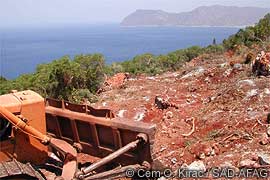 |
|
|
Bulldozers wreak their destruction upon the Datça SPA |
We shot still photos and video footage to document the construction, whose legality seemed highly suspect.
Just before returning to Kormen 3 hours later, a tractor carrying 3 workers appeared behind our van -– obviously sent to question our reasons for being on this road.
After a brief exchange – in which it was claimed that the Datça Chief of the Ministry of Forests had opened the road as a fire prevention measure – we left the area.
In the days following our departure from Datça, we issued strong letters of appeal to all relevant governmental departments, including the Ministries of Environment, Forests and Culture, the Authority for SPAs, the Provincial Governors of Mugla and Datça, and also Datça Municipality. A selection of photos was included to support our written evidence.
In a swift response, and echoing SAD-AFAG's own concerns, the Ministry of Culture and Ministry of Forests ordered the Datça Chief to halt the road construction and also directed their inspectors to investigate.
Our contacts with the Authority for SPAs revealed that ASPA inspectors had also visited Datça's northern coasts and had issued a report advising that the construction be stopped and public access to the site be prevented.
In our opinion, the fire-prevention justification for the road seems dubious – possibly a fake explanation to deceive the public and government officials. In fact, experience shows that human penetration into such forested areas increases, rather than diminishes, the risks of fire. A more plausible explanation is that the road was opened to provide raw material for the charcoal production facilities near Kormen.
Meanwhile, SAD-AFAG is still trying to ascertain why the ASPA provided permission for these facilities to operate, presumably in the knowledge that they would have to depend on local raw material.
It is also possible that a secondary housing cooperative, which owns land on Mersincik bay, might benefit from the road building scheme. Although construction of summer houses has so far been prevented along this coast, the road would provide a strategic short-cut to Kormen, where ferries make regular scheduled runs to the tourism centre of Bodrum – a major and lucrative incentive for development activity.
AFAG has been monitoring the ecologically important Datça Peninsula since 1994. Besides providing a last refuge for endangered monk seal populations along Turkey's southwestern coasts, the Peninsula is also home to other threatened and endangered species, such as the brown bear and ibex, Bonelli's eagle, Eagle owl and Eleonora's falcon.
According to our latest reports from Datça, heavy construction equipment has now been withdrawn from the site, although rumours persist that the road building will recommence next year when public attention has died down.
Committed to preserving Datça's unique ecological legacy, SAD-AFAG is now seeking court action against those responsible for the road construction and the damage it has caused. Successful prosecution of the case would not only punish the guilty parties involved, but would also act as a deterrent to other potential offenders. – Cem Orkun Kiraç, SAD-AFAG.
In July 2002, SAD-AFAG carried out a preliminary survey along the coasts of the Dilek Peninsula National Park in an effort to identify suitable seal caves. Dilek, Turkey's first coastal national park, was established in 1966 and was also the site of SAD-AFAG's very first expedition in 1988.
During that survey we also observed our first monk seals – two individuals swimming together towards the adjacent Greek island of Samos.
During this year's expedition, our team checked and drew plans of the 3 caves previously identified in 1988. Unfortunately, we could detect no evidence of seal use.
Despite those disappointing results, a local fisherman reported seeing a seal hauling out onto a rocky platform on the southern coasts of the Park in spring 2002. Historical evidence also suggests that monk seals might be visiting Dilek on a seasonal basis, possibly from Samos.
Our research team also filmed the underwater life of the NP, which will be used for a documentary on Dilek prepared for the Ministry of Forestry (National Parks, Game and Wildlife General Directorate). – Harun Güçlüsoy & Yalçin Savas, SAD-AFAG.
Last May, at the official invitation of the Ministry of Environment's Izmir Directorate, SAD-AFAG participated in a meeting to design an action plan for the protection of marine turtles and monk seals along the Province's coasts.
SAD-AFAG recommended the adoption of the "Conservation Guidelines" compiled by Johnson & Lavigne [Monachus Library: Johnson, William M., and David M. Lavigne. 1998.] for the protection of these species in the area.
The meeting's primary focus, however, was on the rescue and rehabilitation of stranded animals and necropsy procedures for individuals found dead. At the end of the meeting, SAD-AFAG was nominated to draw up an action plan for the rescue and the rehabilitation of monk seals and other marine mammals. – Harun Güçlüsoy, SAD-AFAG.
SAD-AFAG's monk seal adoption campaign, which began in 1998 in co-operation with DHKD, was re-launched in April by the Mediterranean Seal Research Group (AFAG).
The previous campaign ran only for one year but its potential convinced AFAG to re-launch the programme. At first, the re-launch drew little public or media attention, with the result that only one supporter signed up to become a seal 'mother'.
Fortunes changed dramatically, however, when we issued another press release in September, explicitly drawing attention to the poor showing of public support. Five newspapers responded, carrying dramatic headlines such as "Monk Seals Left Orphans". In the week that followed, we received 131 phone calls enquiring about the adoption campaign.
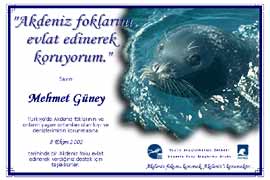 |
|
|
Adoption certificate |
Three types of monk seal adoption are offered:
Each comes complete with an adoption certificate and an informative welcoming letter, along with recent news updates about the monk seals under AFAG's protection. Those signing up to mother/father adoptions also receive an appealing framed photograph of a monk seal. Donations received will be applied directly to AFAG'S monk seal conservation efforts.
For more information on the adoption campaign, please contact AFAG'S Coordination Office in Ankara. – Yesim Öztürk, SAD-AFAG.
"Rastgele", the Fishermen's and Marine Documentaries Film Festival, was held for the second consecutive year on 14-18 August 2002 in Foça. Organised by the Association of Documentary Filmmakers in Turkey (BSB), Foça Local Agenda 21, SAD-AFAG, Foça Municipality and the Fishermen of Foça, the festival featured documentary film shows, conferences and fora on fisheries and fisheries policy, competitions and concerts.
During the fora, fishermen shared their experiences, trying to pinpoint possible solutions for the significant problems facing coastal fisheries today.
"Local people and the fishermen of Foça have been the backbone of our monk seal conservation activities for almost a decade now," said Yalçin Savas, Head of Conservation for SAD-AFAG and member of the festival organisation committee. "Their participation in our efforts and in this festival is an important element of coastal and marine conservation in Turkey."
Parallel discussion groups were convened on "Safety for Tour and Fishing Boats – International Regulations", "Social Security Rights of Fishermen", and "European Union and Fisheries Policies".
Every evening, film documentaries were screened in Beskapilar, the medieval fortress of Foça, including entries from Turkey, Belgium, Cyprus, France, Germany, Ghana, Israel, Italy, Portugal, Scotland, Spain, and USA.
As in last year's festival, some of the most popular activities involved good-natured competitions between fishermen, including hook binding, net repairing, fishing and boat races.
The festival is supported by IULA – EMME (the International Union of Local Authorities), UNDP (United Nations Development Programme), WWF (World Wide Fund for Nature), Foça Local Governorship, Foça Municipality and Foça Fisheries Cooperative.
Cem Kiraç, Coordinator of SAD-AFAG said: "We are currently involved in an EU-funded project, in partnership with WWF (World Wide Fund for Nature), and are working to find solutions for people who depend on the sea for their livelihoods. The Rastgele festival is a significant step towards the solution." – SAD-AFAG.
The Bozyazi Nature Festival, organized by SAD-AFAG in cooperation with the Documentary Film Makers Association and Içel Amateur Photographers Society, took place between 29 June - 1 July 2002 and received substantial support from Bozyazi Municipality. Like its counterpart in Foça, the festival featured documentaries on marine and fisheries issues, but also an exhibition of drawings and paintings from the contest held every year among the schools of Bozyazi. – Yesim Öztürk, SAD-AFAG.
The court case that commenced on 21 April 1999 challenging the "Annual Aqua Products Circular 33/1" issued on 21 February 1999 has been concluded, with judgement being awarded against the plaintiffs.
The legal action was taken by the Yeni Foça and Urla Fishing Co-operatives, the Turkish Association for the Protection of Nature and Natural Resources and SAD-AFAG, and was later supported by the Mordogan, Bogazici, Dikili, Balikliova, Çesmealti, Foça and Karaburun Fishing Co-operatives. The clauses that the legal action requested the court to amend are listed in a previous TMG news item: Court action follows artisanal fisheries symposium, TMG 2 (2): November 1999.
The Public Court rejected the request to suspend enactment of the circular on the grounds that it had been prepared by taking into consideration the views of the entire sector, including scientific institutions. Although trawler nets drag along the seabed, this was not the case for purse-seine fishing and hence these two systems could not be compared, the Court found. The claims made by the plaintiffs, the Court concluded, were not based on verifiable scientific fact.
The Public Court, however, did not deem it necessary to consult an independent expert to examine these claims, and based its final decision entirely on the defence presented by the Ministry of Agriculture and Rural Affairs. In the final statement of the decision, the only clause that was directly addressed concerned the Lampara fishery (a form of night purse-seine fishing – girgir in Turkish, grigri in Greek – utilising powerful lights). During the case's 2-year duration, however, a circular was issued by the Ministry of Agriculture and Rural Affairs addressing two more clauses that the plaintiffs requested be amended. The 34/1 circular, issued on 31 July 2000, prohibited the use of coastal seines on Aegean and Mediterranean coasts (except for Ayvalik) and the live catching of small fish (mainly to stock fish farms). In light of firm scientific data, SAD-AFAG will continue its efforts to change the depth limit of the Lampara fishery to "deeper than 50 meters and at least 1.5 miles away from the coast". – Yalçin Savas and Harun Güçlüsoy, SAD-AFAG.
On Sunday 7 July the phone rang at our home in Karaburun. It was Mr. Ayhan Akçura of the Karaburun Civil Defense Force.
"Ozan," he said, "we have, I think, found a monk seal pup, dead, lying underwater. Please do come here as soon as possible."
Thirty minutes later, we were already at the scene of the incident, at Aslan Burnu (Lion Cape). As soon as I had suited up in diving gear, I went into the water to investigate.
At about 4 meters' depth I spotted a furry body with white and black patches. It was a female newborn monk seal pup. From its appearance and state of decomposition, it looked as if the animal had died several days earlier.
The body was taken out of the water and put in a plastic container. We then returned to Karaburun, keeping the body in the freezer of a refrigerator overnight. The next morning, using an icebox, we took the dead seal to the Veterinary Research Institute of the Ministry of Agriculture and Rural Affairs in Izmir.
According to the necropsy, completed on 8 July by AFAG members and specialists, the estimated date of death was 5 July 2002. The animal was then thought to be 1-2 days old. The body weight was estimated at 5 kg, the animal's total length (nose to hind flippers), 75 cm. No sign of milk intake was found in the stomach. Based on these and other observations, it is suspected that the animal drowned during birth at sea or at an unsuitable location (by a possibly inexperienced mother). It was also considered possible that the birth may have taken place abruptly and unexpectedly in an inappropriate place.
Following our team's return to Karaburun, we began a detailed inquiry on possible monk seal sightings at Aslan Burnu. After a weeklong effort to reach secondary house owners and lift-net fishermen in the area, we eventually learned that an adult monk seal had been seen in the days prior to the pup's death. Although the exact times differed according individual informants, it seems that an adult seal had screamed for hours during the daylight hours of Thursday 4 July, at the exact location where the pup had subsequently been found dead.
It is a pity that no one alerted the SAD-AFAG team at the time. – N. Ozan Veryeri, SAD-AFAG.
From 25 October to 3 November, a small party of dedicated "monk seal fans" – under the guidance of Luigi Guarrera, co-ordinator of the Italian monk seal group, Gruppo Foca Monaca – visited SAD-AFAG's Cilician Basin conservation project, led by Dr. Ali Gücü of Middle East Technical University. The project receives funding support from WWF MedPO.
Guarrera, a former co-ordinator of WWF's Mediterranean Programme and an initiator of the Cilician monk seal conservation project, considers this first ecological tour a pilot project that may warrant further development through WWF Italy's Education Office. Starting as early as spring 2003, he believes, it is possible that small groups of nature lovers may be visiting the WWF-supported monk seal conservation projects in Cilicia and Foça 2-3 times a year.
While it is hoped that the "ecotourists" will observe monk seals, every effort is being made to eliminate potential disturbance, including careful guidance and instruction by experienced project leaders. The visitors are also likely to provide an important contribution to one of the principal aims of the project: to instil within local people, especially the fisherman, a sense of ownership for their Marine Protected Area and to convince them that sensible "seal tourism" is not only possible but will also benefit their livelihoods.
With this aim in mind, the October expedition to the Cilician project relies on local involvement wherever possible – for instance, by hiring the boats of artisanal fisherman for coastal trips.
The itinerary of the Cilician tour attempts to meld ecological, archaeological and cultural influences. Highlights include a boat trip to the Bozyazi-Kizilliman Marine Protected Area, seal-watching from cliff-top archaeological sites, visits to abandoned seal caves, swimming and snorkelling from isolated beaches, early morning fishing expeditions with local fishermen, and hikes through some of the Mediterranean's most unspoilt landscapes. Further information is available on the Gruppo Foca Monaca website, http://www.focamonaca.it.
Effective management plans for protected areas, stakeholder participation in the conservation process and no-fishing zones to benefit seals, fishermen and the marine ecosystem at large, are among the principal objectives of AFAG's collaborative project with WWF MedPO [see Coastal zone management project commences, TMG 5 (1): May 2002].
In Turkey, the EU-funded initiative – "Conservation and Management of Biodiversity Hotspots: Developing a Mediterranean Network" – is focusing on the following conservation areas: Foça and the adjacent Karaburun Peninsula near Izmir; and Aydincik (near Bozyazi, where AFAG's Mediterranean Office is based).
So far, several important steps have been accomplished in meeting the project's targets, among them:
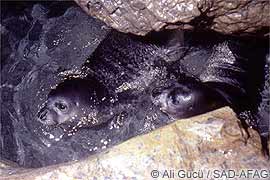 |
|
|
Monk seal pups in the Cilician Basin |
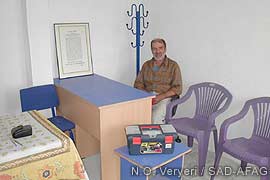 |
|
|
The head of the Yeniliman Fishing Cooperative, with office furniture donated through the AFAG-WWF SMAP project |
In a follow-up to the Marine Protected Area workshop held last January [see AFAG attends MPA workshop in Dalaman, TMG 5 (1): May 2002], a second meeting was held under the auspices of the Ministry of Environment on 20 May 2002 in Ankara. Relevant Ministries, Universities, Institutes and NGOs, including SAD-AFAG, participated in the meeting which, like its forerunner, sought to identify problems and solutions affecting the establishment and operation of marine protected areas in Turkey.
During both meetings, the main problem was found to be legislative. Even though MPAs have been established in Turkey, it is now evident that there are conflicts and fragmentation of responsibility between the ministries involved and between different articles of national legislation. In concluding, the meeting resolved to establish a technical committee formed by SAD-AFAG, WWF Turkey, METU-Institute of Marine Sciences, Turkish Marine Research Foundation (TUDAV) and the Turkish National Committee on Coastal Zone Management (KAY), to prepare a status report on the MPAs in Turkey, including their legislative aspects.
The technical committee convened to assess their available information on 14 June 2002 at the METU campus and members examined relevant Turkish legislation to ascertain its compatibility with IUCN Guidelines for MPAs. The resulting report was submitted to the Ministry of Environment on 20th of August 2002.
According to SAD-AFAG's research, more than 1200 km of Turkish coastline has varying degrees of protection status (accorded by different authorities). Many important coastal areas are designated as National Parks, Nature Parks, Nature Protection Areas or SPAs. Unfortunately, however, none of these areas has a management plan or specific guarding system.
According to AFAG's analysis of the MPA problem:
Unfortunately, considering the amount of the work required and the financial implications, it is likely that preparation and implementation of management plans for Turkish MPAs – including effective guarding systems – will take a decade or more. – Yalçin Savas & Harun Güçlüsoy, SAD-AFAG.
Members of Croatia's Mediterranean Monk Seal Group (Grupa Sredozemna Medvjedica) visited Foça and Karaburun between 13 and 24 October 2002, as part of an exchange programme promoted by the WWF MedPO Across the Waters initiative.
The Croatian visitors and their Turkish counterparts within SAD-AFAG participated in roundtable discussions, presentations and field excursions, sharing knowledge and experiences on broad-ranging issues, including scientific research, MPA management and guarding, seal-fisheries interactions, seal rehabilitation and necropsy procedures.
Further information on the exchange programme is available on the MedPO, Across the Waters web site.
Additional details of AFAG's participation in the exchange is available at: http://www.atw-wwf.org/portxchg/15.htm.
– Harun Güçlüsoy, SAD-AFAG.
SAD-AFAG has launched the fourth phase of its Project Seal Watch whose main aim is to monitor in-cave behavior of the monk seal – the most hidden part of the species' life cycle.
The first phase was implemented in 1997 in collaboration with the Gruppo Foca Monaca, Panda Film and the Italian electric utility ENEL, on Orak Island, Foça, using a video camera, two infrared illuminators and a microphone [see Private Lives under Investigation, TMG 1 (2): December 1998]. The subsequent study in 2000 focused on a cave close to the town of Bozyazi on the Turkish Mediterranean coast. In this second phase, accomplished with the financial support of WWF Belgium, three cameras and IR illuminators and a microphone were installed in the cave [see Monk seal behaviour under surveillance, 3 (1): May 2000]. The audio-visual data were transmitted via a broadcast link system about 2 km away from the cave to the monitoring centre. The third phase, also in 2000, was carried out in the Ayibaligi Cave near Mordogan, on the Karaburun Peninsula, using surplus equipment from phase two [see Video monitoring on Karaburun, 4 (1): May 2001].
By November 2002 the fourth phase of the project commenced at the same site, which research indicates is the most important breeding cave within the Gulf of Izmir.
The project receives funding support from the Scientific and Technical Research Council of Turkey and the Van Tienhoven Foundation of the Netherlands.
Although the cave is only about a kilometer away from Mordogan town centre, and is surrounded by numerous summer houses and a nearby café, when autumn arrives and the schools re-open after the long summer break, the area quickly becomes deserted. Seals have used the cave for giving birth for the last three consecutive years.
For the purposes of the Seal Watch project, the cave has now been equipped with four monochrome cameras and IR illuminators and two microphones. One of the units malfunctioned after installation, leaving three units operating normally. Audio-video signals are delivered through a 250 meter long cable to the observation unit, based in a small, two-room building adjoining the nearby café. The observation unit comprises a VHS recorder capable of 24-hour continuous recording, monitors for each camera unit, and a multiplexer with digital motion sensor.
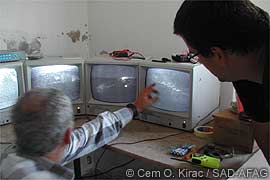 |
|
|
A bank of monitors begins to receive the first images from the Mordogan cave |
Although originally designed to gather data on little-understood aspects of monk seal breeding and mother-pup relations, it now appears that this year's breeding season may pass without a birth in the Mordogan cave. The discovery in July of an aborted foetus weighing 5 kg along the same stretch of coast (about 15 km from the cave) may mean that Ayibaligi cave will not see a newborn pup this season [see Pup found dead on Karaburun, above]. More human disturbance this year – with late summer weather enticing seasonal residents of summer houses to linger longer than normal – may also have had an impact, making pregnant mothers too uneasy to trust the cave.
Although we may have to wait for a monk seal birth until next year, the system has already delivered its first seal images. The first seal to be observed, in fact, was an old friend from Phase one, previously captured on video in 1997 on Orak Island. She stayed less than a day in the cave. AFAG's Karaburun team named her "Foça".
Recently, SAD-AFAG received political support for the Seal Watch project from the Mayor of Mordogan, Mr. Ferhan Eroglu, who has agreed to ban human activities in close proximity to the cave. Fishing has already been prohibited around the cave – up to a water depth of 20 meters – by the Ministry of Agriculture's last biannual Aqua Products Circular [see Progress reported in coastal zones project, above]. – Yalçin Savas, SAD-AFAG.
The Mediterranean Seal Research Group (AFAG) is celebrating its 15th anniversary.
Established in September 1987, "Akdeniz Foku Arastirma Grubu" – as it is known in Turkish – started out as an amateur student group in the Middle East Technical University, and as an offshoot of the METU-Subaqua Society. A message of encouragement from Turkish-Canadian Professor Fikret Berkes in Ontario proved instrumental in founding the Group. Prof. Berkes, who had already conducted several monk seal surveys along Turkish coasts, emphasised the importance of further surveys and practical conservation measures if the species was to have any hope of survival in Turkey.
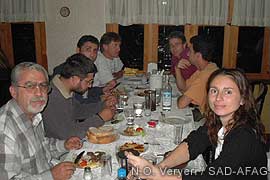 |
|
|
AFAG's 15th anniversary celebrations on Karaburun |
With only 3 or 4 active members and a paltry budget, our Group's scope for action remained severely limited until a fixed meeting place was established at my own home in Ankara in 1991. Sustained efforts in public awareness – particularly through seminars and the mass media – soon yielded important benefits to the campaign and to the strength of our Group.
With more active members filling its ranks, AFAG was soon conducting field research, public awareness and environmental education campaigns along Turkey's Black Sea, Aegean and Mediterranean coasts. In terms of lobbying and expertise, the Group also made a significant contribution towards the establishment of Turkey's National Monk Seal Committee in 1991. Meanwhile, we were also in frequent contact with Professor Bahtiye Mursaloglu, benefiting from her profound knowledge and experience on monk seals and marine research methodologies.
Turkey's first applied conservation and coastal zone management project, "Conservation of the Mediterranean monk seal in Turkey – Foça Pilot Project", was awarded to AFAG in 1993 and has been successfully implemented by Yalçin Savas and Harun Güçlüsoy ever since. The project received the prestigious Henry Ford European Conservation Award Grand Prix in 1998.
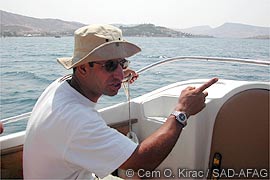 |
|
|
SAD-AFAG's Yalçin Savas in the Foça SPA patrol boat, Cevre |
AFAG's strength took another leap when, in 1994, we joined forces with the Underwater Research Society (SAD) and merged with a group of scientists and monk seal conservationists in METU-IMS (Middle East Technical University-Institute of Marine Sciences) in 1998 to form a more organized structure throughout Turkey.
Building on a growing public support base, AFAG now has a sizeable volunteer and member network. Even today, 15 years after its founding, AFAG remains the first and only NGO in Turkey working for the conservation of the Mediterranean monk seal.
AFAG now runs 3 field project offices – in Foça and Karaburun on the Aegean, and in Bozyazi on the Mediterranean. Liaison offices are run out of Datça and Adana, and a coordination office operates from Ankara. At present there are 14 full-time or volunteer core staff and around 400 members.
This year in March, AFAG commenced an EU-funded project in partnership with WWF, aimed at creating marine conservation areas with no-fishing-zones along Turkish coasts, in partnership with local fishermen.
The last 15 years have seen some notable achievements for AFAG. We aimed our awareness campaigns at the general public, coastal inhabitants and, not least of all, government departments. Whereas 15 years ago the monk seal was hardly ever mentioned outside fishermen's villages, today the species appears frequently in the press and media. That, in turn, brings pressure to bear on government departments to fulfil the conservation obligations that are required of them.
During these last 15 years, we have also halted several unplanned and even illegal coastal developments in monk seal habitat, and have played a central role in establishing official protected zones along our coasts [see TMGs, passim].
Despite these accomplishments, I realize that there are many more things still left to do if we are to ensure the survival of this beautiful marine mammal and its "home" – our diminishing pristine coasts.
After our first 15 years, we have an enthusiastic, determined and hard-working staff backed by hundreds of sea-loving members. We also have the expertise and experience to deliver the conservation results expected of us.
What we require now is the financial backing – from both national and international conservation funding institutions – to support and partner our efforts. – Cem Orkun Kiraç, SAD-AFAG.
NET WATCHMass tourism versus monk seals..."As a major cause of the loss of natural habitat, tourism has a very direct negative impact on biodiversity, directly affecting rare and endangered species. Over 500 plant species in the Mediterranean are threatened with extinction and are under intense pressure from tourism development in some overbuilt destinations. In Zakynthos (Greece), sea turtles have had their coastal nesting grounds disturbed and destroyed by tourism development and tourist behaviour. Tourism's impact on the critically endangered Mediterranean monk seal has been particularly devastating. The biggest impact has been from the loss of its habitat. The monk seal needs suitable cave and beach habitats in order to breed successfully – areas that are exploited by the tourism industry. Already the impact of tourism has played a major role in the decline and extinction of Mediterranean monk seal populations in several key areas including France and Corsica, Spain and the Balearic islands, Croatia, Italy and Sardinia, and Tunisia. Without dramatic changes, the current tourism pressure will likely drive the species to extinction." Source: |
Copyright © 2002 The Monachus Guardian. All Rights Reserved |